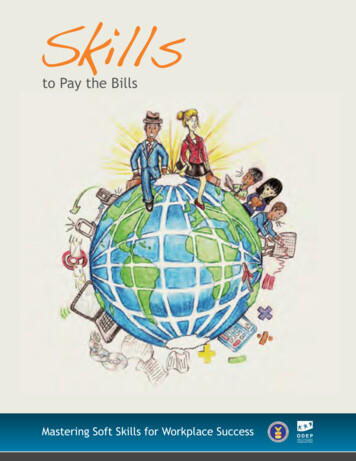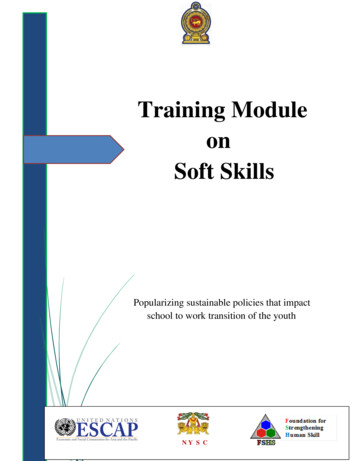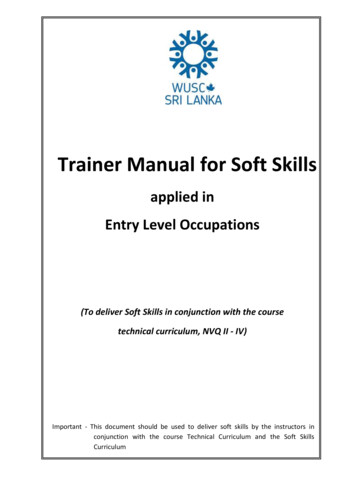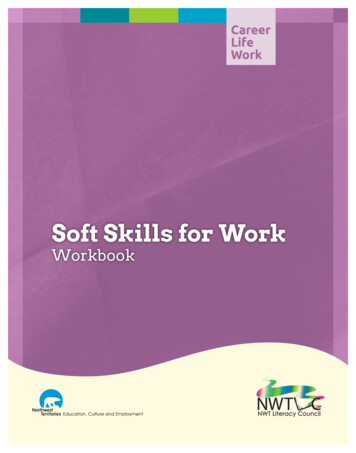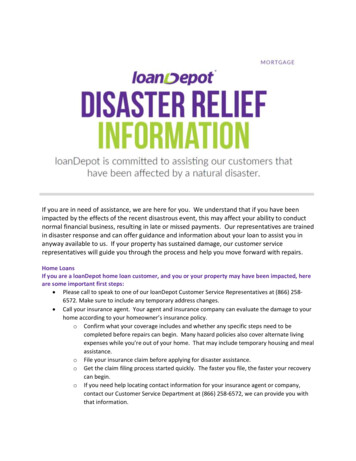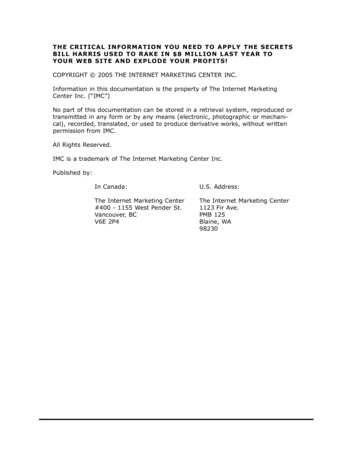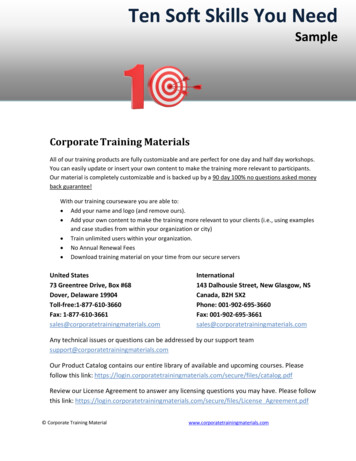
Transcription
Ten Soft Skills You NeedSampleCorporate Training MaterialsAll of our training products are fully customizable and are perfect for one day and half day workshops.You can easily update or insert your own content to make the training more relevant to participants.Our material is completely customizable and is backed up by a 90 day 100% no questions asked moneyback guarantee!With our training courseware you are able to: Add your name and logo (and remove ours). Add your own content to make the training more relevant to your clients (i.e., using examplesand case studies from within your organization or city) Train unlimited users within your organization. No Annual Renewal Fees Download training material on your time from our secure serversUnited States73 Greentree Drive, Box #68Dover, Delaware 19904Toll-free:1-877-610-3660Fax: International143 Dalhousie Street, New Glasgow, NSCanada, B2H 5X2Phone: 001-902-695-3660Fax: omAny technical issues or questions can be addressed by our support teamsupport@corporatetrainingmaterials.comOur Product Catalog contains our entire library of available and upcoming courses. Pleasefollow this link: e/files/catalog.pdfReview our License Agreement to answer any licensing questions you may have. Please followthis link: e/files/License Agreement.pdf Corporate Training Materialwww.corporatetrainingmaterials.com
TABLE OF CONTENTSPreface . 3What is Courseware?. 3How Do I Customize My Course?. 3Materials Required . 5Maximizing Your Training Power . 5Icebreakers. 7Icebreaker: House of Cards . 8Instructor Guide Sample . 9Module Two: What Are Soft Skills? . 10Definition of Soft Skills . 10Empathy and the Emotional Intelligence Quotient . 11Professionalism . 12Learned vs. Inborn Traits . 13Practical Illustration . 14Module Two: Review Questions . 16Appendix . 19Sample Worksheet 1. 20Quick Reference Sheets . 21Certificate of Completion . 24PowerPoint Sample . 26Full Table of Contents . 31 Corporate Training Materialwww.corporatetrainingmaterials.com
PrefaceWhat is Courseware?Welcome to Corporate Training Materials, a completely new trainingexperience!Our courseware packages offer you top-quality training materials thatare customizable, user-friendly, educational, and fun. We provide yourmaterials, materials for the student, PowerPoint slides, and a takehome reference sheet for the student. You simply need to prepare andtrain!Best of all, our courseware packages are created in Microsoft Office and can be opened using anyversion of Word and PowerPoint. (Most other word processing and presentation programs supportthese formats, too.) This means that you can customize the content, add your logo, change the colorscheme, and easily print and e-mail training materials.How Do I Customize My Course?Customizing your course is easy. To edit text, just click and type as you would with any document. This isparticularly convenient if you want to add customized statistics for your region, special examples foryour participants’ industry, or additional information. You can, of course, also use all of your wordprocessor’s other features, including text formatting and editing tools (such as cutting and pasting).To remove modules, simply select the text and press Delete on your keyboard. Then, navigate to theTable of Contents, right-click, and click Update Field. You may see a dialog box; if so, click “Update entiretable” and press OK.(You will also want to perform this step if you add modules or move them around.)If you want to change the way text looks, you can format any piece of text any way you want. However,to make it easy, we have used styles so that you can update all the text at once. Corporate Training Materialwww.corporatetrainingmaterials.com
If you are using Word 97 to 2003, start by clicking the Format menu followed by Styles and Formatting.In Word 2007 and 2010 under the Home tab, right-click on your chosen style and click Modify. That willthen produce the Modify Style options window where you can set your preferred style options.For example, if we wanted to change our Heading 1 style, used for Module Titles, this is what we woulddo:Now, we can change our formatting and it will apply to all the headings in the document.For more information on making Word work for you, please refer to Word 2007 or 2010 Essentials byCorporate Training Materials. Corporate Training Materialwww.corporatetrainingmaterials.com
Materials RequiredAll of our courses use flip chart paper and markers extensively. (If you prefer, you can use a whiteboardor chalkboard instead.)We recommend that each participant have a copy of the Training Manual, and that you review eachmodule before training to ensure you have any special materials required. Worksheets are includedwithin the Appendix of the Instructor Guide and the participant’s Training Manual, and can bereproduced and used where indicated. If you would like to save paper, these worksheets are easilytransferrable to a flip chart paper format, instead of having individual worksheets.We recommend these additional materials for all workshops: Laptop with projector, for PowerPoint slides Quick Reference Sheets for students to take home Timer or watch (separate from your laptop) Masking tape Blank paperMaximizing Your Training PowerWe have just one more thing for you before you get started. Our company is built for trainers, bytrainers, so we thought we would share some of our tips with you, to help you create an engaging,unforgettable experience for your participants. Make it customized. By tailoring each course to your participants, you will find that your resultswill increase a thousand-fold.oUse examples, case studies, and stories that are relevant to the group.oIdentify whether your participants are strangers or whether they work together. Tailoryour approach appropriately.oDifferent people learn in different ways, so use different types of activities to balance itall out. (For example, some people learn by reading, while others learn by talking aboutit, while still others need a hands-on approach. For more information, we suggestExperiential Learning by David Kolb.)Make it fun and interactive. Most people do not enjoy sitting and listening to someone else talkfor hours at a time. Make use of the tips in this book and your own experience to keep your Corporate Training Materialwww.corporatetrainingmaterials.com
participants engaged. Mix up the activities to include individual work, small group work, largegroup discussions, and mini-lectures. Make it relevant. Participants are much more receptive to learning if they understand why theyare learning it and how they can apply it in their daily lives. Most importantly, they want toknow how it will benefit them and make their lives easier. Take every opportunity to tie whatyou are teaching back to real life. Keep an open mind. Many trainers find that they learn something each time they teach aworkshop. If you go into a training session with that attitude, you will find that there can be anamazing two-way flow of information between the trainer and trainees. Enjoy it, learn from it,and make the most of it in your workshops.And now, time for the training! Corporate Training Materialwww.corporatetrainingmaterials.com
IcebreakersEach course is provided with a wide range of interactive Icebreakers. The trainer can utilize anIcebreaker to help facilitate the beginning of the course, as it helps “break the ice” with theparticipants. If the participants are new to each other, an icebreaker is a great way to introduceeveryone to each other. If the participants all know each other it can still help loosen up theroom and begin the training session on a positive note. Below you will see one of theicebreakers that can be utilized from the Icebreakers folder. Corporate Training Materialwww.corporatetrainingmaterials.com
Icebreaker: House of CardsPURPOSE1. To help participants get to know each other2. To identify participants’ goals for the sessionMATERIALS REQUIRED3. One playing card per participant, with an equal number of cards from each suit4. Several sets of markers5. Flip chart paperPREPARATIONPass out one playing card to each participant, face-down.ACTIVITYOn your cue, ask participants to turn over their playing cards. They are to find others with their suit, butthey are not allowed to talk or show their card. For example, if a person had a spade, they may illustratethat by pretending to dig a hole.Once participants are in their groups, they are to introduce themselves and come up with a list of fivethings that they would like to learn during the workshop.DEBRIEFOnce groups have created their list, bring participants back together. Have each group present their listand combine topics on the flip chart. Use this as a guide during the workshop. If there are any topicsthat will not be covered, let participants know where they can find more resources (such as follow-upworkshops or materials from the Recommended Reading List). Corporate Training Materialwww.corporatetrainingmaterials.com
Instructor Guide SampleOn the following pages is a sample module from our Instructor Guide. It provides the instructorwith a copy of the material and a Lesson Plans box.The key benefit for the trainer is the Lesson Plan box. It provides a standardized set of tools toassist the instructor train that particular lesson. The Lesson Plan box gives an estimated time tocomplete the lesson, any materials that are needed for the lesson, recommended activities, andadditional points to assist in delivering the lessons such as Stories to Share and Delivery Tips. Corporate Training Materialwww.corporatetrainingmaterials.com
I think we all have empathy. We may nothave the courage to display it.Maya AngelouModule Two: What Are Soft Skills?What are soft skills, anyway? Simply put, soft skills are the personalattributes that allow us to effectively relate to others. These skillsenhance our personal interactions and lead to greater jobperformance and satisfaction. Unlike hard skills, which are thetechnical and knowledge skill set we bring to our work, soft skills areinterpersonal and can be applied in a broad array of situations. Softskills encompass both personality traits, such as optimism, andabilities which can be practiced, such as empathy. Like all skills, softskills can be learned.Definition of Soft SkillsSoft skills are personal attributes that allow us to effectively relate toothers. Applying these skills helps us build stronger workrelationships, work more productively, and maximize our careerprospects. Often, we place the focus of our career developmentefforts on hard skills – technology skills, knowledge, and other skillsthat specifically relate to our ability to get work-related tasks done. This means we neglect to developour soft skills. However, soft skills are directly transferrable to any job, organization, or industry. As aresult, they are an investment worth making.Soft skills include: CommunicationListeningShowing empathyNetworkingSelf-confidenceGiving and receiving feedback Corporate Training Materialwww.corporatetrainingmaterials.com
Estimated Time8 minutesTopic ObjectiveIntroduce the concept of Soft SkillsSoft SkillsTopic SummaryDiscuss the concept of soft skills.Materials RequiredFlip board/chart and markersPlanning ChecklistNoneRecommended ActivityAs a group, discuss soft skills. Brainstorm soft skills that class members useevery day. List these on the board.Stories to ShareShare any personal or relevant stories.Delivery TipsInvite individual participants to share their nightly routines.Review QuestionsWhat are soft skills?Empathy and the Emotional Intelligence QuotientEmpathy is perhaps the most important soft skill we can develop for betterinterpersonal interactions. Empathy is the ability to identify with another person’sexperience. While we often think of empathy in terms only of identifying withsomeone’s pain or negative experience, we can apply empathy in a variety ofsituations. Developing empathy allows us to imagine ourselves in anotherperson’s shoes, to respond to others, and even to vicariously experience others’feelings of emotions. When we demonstrate empathy, we create connections with others, which canhelp to build teamwork or otherwise create shared goals. Empathy also helps to forge strongerinterpersonal connections between team members and colleagues, which is as important as sharedgoals or complementary skills, when it comes to accomplishing work.Empathy is one component of what is known as Emotional Intelligence, or EI. Emotional Intelligence isthe ability to recognize and manage our feelings so that they are expressed appropriately. Exercisingemotional intelligence helps to create harmonious, productive relationships. There are four keycomponents to Emotional Intelligence: Self-awareness: The ability to recognize our own feelings and motivationsSelf-management: The ability to appropriately express (or not express) feelingsSocial awareness: Our ability to recognize the feelings and needs of others, and the norms of agiven situationRelationship management: Our ability to relate effectively to others Corporate Training Materialwww.corporatetrainingmaterials.com
Taken together, these skills make up our Emotional Intelligence Quotient (EQI). The EQI is a measure ofyour ability to exercise soft skills such as empathy.Estimated Time8 minutesTopic ObjectiveIntroduce the concept of Emotional IntelligenceEmotional IntelligenceTopic SummaryDiscuss the concept of Emotional Intelligence.Materials RequiredWorksheet 1-Emotional IntelligencePlanning ChecklistNoneRecommended ActivityComplete the worksheet individually. Share answers with the class ifdesired.Stories to ShareShare any personal or relevant stories.Delivery TipsEncourage everyone to participate.Review QuestionsHow can we demonstrate emotional intelligence?ProfessionalismThe word “professionalism” often conjures up images of a cold, distant, brusqueperson in a nondescript navy-blue suit. In fact, many people have the sense thatto be “professional” is exactly the opposite of demonstrating empathy andemotional intelligence! However, professionalism is a key soft skill, and it doesn’trequire you to be inauthentic, distant, or detached. Professionalism is simply theability to conduct yourself with responsibility, integrity, accountability, and excellence. Acting withprofessionalism also means seeking to communicate effectively with others and finding a way to beproductive. Professionalism involves what may seem to be small acts, such: Always reporting to work on time and returning promptly from breaksDressing appropriatelyBeing clean and neatSpeaking clearly and politely to colleagues, customers, and clientsStriving to meet high standards for one’s own work Corporate Training Materialwww.corporatetrainingmaterials.com
Estimated Time12 minutesTopic ObjectiveProfessionalismProfessionalismTopic SummaryExplore the concept of professionalismMaterials RequiredFlipboard/chart and markersPlanning ChecklistNoneRecommended ActivityHave the class brainstorm traits or actions that they feel demonstrateprofessionalism and lack of professionalism. List these on the board.Stories to ShareShare any personal relevant stories.Delivery TipsEncourage everyone to participate.Review QuestionsHow can we strive to demonstrate professionalism?Learned vs. Inborn TraitsBecause soft skills are talked about as traits of a person’s personality, it may seem asthough you have to born with them. While some soft skills come more easily to oneperson than they might to another, soft skills are not inborn. Like all skills, they can belearned. Because we all have our own preferences and ways of moving through theworld, some soft skills may be more difficult to learn than others. But if we think back,there are also aspects of our hard skill set that were difficult at first, though they now seem to comequite naturally to us. We develop soft skills in the same way we develop hard skills – we practice!Spending time with people who seem to be able to effortlessly demonstrate a soft skill that you findchallenging is one way to build your soft skill set. Another way is to seek opportunities to practice inwhich the risk of failure is low, until you feel confident in your ability. You don’t have to be born anetworker or an empathetic person – you can learn and build these skills throughout your career.Estimated Time12 minutesTopic ObjectiveIntroduce the concept of building soft skillsBuild Soft SkillsTopic SummaryConsider ways in which we can build and practice soft skills. Corporate Training Materialwww.corporatetrainingmaterials.com
Materials RequiredFlipchart/board and markerPlanning ChecklistNoneRecommended ActivityHave the class brainstorm ideas for how we can build and practice softskills.Stories to ShareShare any personal, relevant stories.Delivery TipsEncourage everyone to participate.Review QuestionsHow can we build soft skills?Practical IllustrationDee was just not a “people person.” She preferred to work by herself, and her position ather company allowed her to do that most of the time. She valued her productivity and herability to meet deadlines and exceed expectations, and anything that got in the way of thatwas an annoyance. When she had to interact with coworkers throughout the day, shepreferred to keep the interactions as brief as possible so she could get back to work. Hercoworker Angela mentioned that people often found Dee unapproachable. “I’m just notwired to be social,” Dee told her. “I don’t relate well to others when I feel like they’re wasting my time.I’ve always been a loner – it just comes naturally to me.” Angela explained that she also preferred tofocus on her tasks and work independently, but she had learned to relate to her coworkers so that shecould have a more harmonious work experience.Angela encouraged Dee to try changing her approach to coworkers, to try to see them not asinterruptions, but as fellow humans who were worth paying attention to. Dee decided to try this,though it was hard for her. The next time a coworker interrupted her while she worked, Dee tried toreally listen to what he needed rather than rushing him out of her office. She realized that hercoworkers often didn’t come to her until things were in crisis because they found her distant. She thenrealized that cultivating better relationships was a way to prevent crises in the workday.Estimated Time5 minutesTopic ObjectiveOutline the What are Soft Skills Practical Illustration.Practical IllustrationTopic SummaryDiscuss the importance of soft skills for workplace happiness.Materials Required Corporate Training MaterialNonewww.corporatetrainingmaterials.com
Planning ChecklistNoneRecommended ActivityDiscuss the outcome of the Practical Illustration.Stories to ShareShare any personal, relevant stories.Delivery TipsEncourage everyone to participate.Review QuestionsHow did Dee view soft skills? Corporate Training Materialwww.corporatetrainingmaterials.com
Module Two: Review Questions1.) Which of the following are true of soft skills?a)b)c)d)They are aspects of a person’s personalityThey are actions as well as characteristicsThey can promote better workplace efficiencyAll of theseSoft skills are aspects of a person’s personality that impact how he or she interacts with others.They are learned, and encompass both characteristics and actions.2.) The technical and knowledge skills we bring to our jobs are known as which of the following?a)b)c)d)Soft skillsHard skillsEINone of theseThe technical and knowledge skills we bring to our work are known as hard skills. These are onlyone component of workplace success. Soft skills are also important.3.) The ability to identify with another’s feelings is known as which of the following?a)b)c)d)EmpathySympathyProjectionRole playingEmpathy is the ability to identify with another’s feelings. Demonstrating empathy is a key softskill.4.) Which of the following are components of emotional Relationship managementAll of the aboveThere are four domains of emotional intelligence (EI). These are self-awareness, selfmanagement, social awareness, and relationship management. Corporate Training Materialwww.corporatetrainingmaterials.com
5.) The ability to recognize our feelings and express them appropriately is known as which of thefollowing?a)b)c)d)Psychological intelligenceEmotional intelligenceEmotional regulationEmotion managementEmotional intelligence is the ability to recognize our emotions and express them appropriately.Emotional intelligence is key to developing strong soft skills.6.) Professionalism does NOT require which of the following?a)b)c)d)Acting with integritySeeking to always be productiveCommunicating clearly with othersMaintaining a wide emotional distance from colleaguesProfessionalism requires that a person always act with integrity, accountability, andresponsibility. He or she should always seek to communicate clearly and be productive. Wideemotional distance is not required, and can even undermine professionalism.7.) Which of the following is NOT true of soft skills?a)b)c)d)They are inbornThey can enhance productivityThey can enhance work satisfactionAll of the aboveSoft skills are not inborn – they can be learned. Some skills come easier than others based onour experiences and personal preferences, but none of them are hardwired into us!8.) Which of the following is the best way to develop soft skills?a)b)c)d)Research themWatch other people apply themPracticeNone of the aboveBecause soft skills can be learned, the best way to develop them is to practice! Professionaldevelopment courses and mentoring can help you identify opportunities for practice. Corporate Training Materialwww.corporatetrainingmaterials.com
9.) Speaking clearly and politely to colleagues, customers, and clients is an example of what?a)b)c)d)IntelligenceGood communicationProfessionalismB and CProfessionalism involves what may seem to be small acts, such: Always reporting to work on time and returning promptly from breaksDressing appropriatelyBeing clean and neatSpeaking clearly and politely to colleagues, customers, and clientsStriving to meet high standards for one’s own work10.) What might be the result of increasing your level of tionAll of the aboveDeveloping empathy allows us to imagine ourselves in another person’s shoes, to respond toothers, and even to vicariously experience others’ feelings of emotions. When we demonstrateempathy, we create connections with others, which can help to build teamwork or otherwisecreate shared goals. Corporate Training Materialwww.corporatetrainingmaterials.com
AppendixDuring the facilitation of a lesson, Worksheets may be utilized to help present the material. If alesson calls for a Worksheet it will be listed in the Lesson Plan box under Materials Required.The trainer can then utilize the Appendix of either the Instructor Guide or the participant’sTraining Manual for the corresponding material and then provide it to the participants. Corporate Training Materialwww.corporatetrainingmaterials.com
Sample Worksheet 1Emotional IntelligenceIn this space, reflect on your own Emotional Intelligence. Which skills do you think you apply well?Which are hard for you? Corporate Training Materialwww.corporatetrainingmaterials.com
Quick Reference SheetsBelow is an example of our Quick Reference Sheets. They are used to provide the participantswith a quick way to reference the material after the course has been completed. They can becustomized by the trainer to provide the material deemed the most important. They are a waythe participants can look back and reference the material at a later date.They are also very useful as a take-away from the workshop when branded. When a participantleaves with a Quick Reference Sheet it provides a great way to promote future business. Corporate Training Materialwww.corporatetrainingmaterials.com
Corporate Training Materialwww.corporatetrainingmaterials.com
Corporate Training Materialwww.corporatetrainingmaterials.com
Certificate of CompletionEvery course comes with a Certificate of Completion where the participants can be recognizedfor completing the course. It provides a record of their attendance and to be recognized fortheir participation in the workshop. Corporate Training Materialwww.corporatetrainingmaterials.com
CERTIFICATE OF COMPLETION[Name]Has mastered the courseTen Soft Skills You NeedAwarded this day of e , 20Presenter Name and Titlewww.corporatetrainingmaterials.com Corporate Training Material
PowerPoint SampleBelow you will find the PowerPoint sample. The slides are based on, and created from, theInstructor Guide. PowerPoint slides are a great tool to use during the facilitation of thematerial; they help to focus on the important points of information presented during thetraining. Corporate Training Materialwww.corporatetrainingmaterials.com
Corporate Training Materialwww.corporatetrainingmaterials.com
Corporate Training Materialwww.corporatetrainingmaterials.com
Corporate Training Materialwww.corporatetrainingmaterials.com
Corporate Training Materialwww.corporatetrainingmaterials.com
Full Table of ContentsPreface . 7What is Courseware?. 7How Do I Customize My Course?. 7Materials Required . 9Maximizing Your Training Power . 9Module One: Getting Started . 11Housekeeping Items . 11The Parking Lot . 12Workshop Objectives . 12Action Plans and Evaluation Forms . 13Action Plan . 14Evaluation Form . 15Pre-Assignment .
Download training material on your time from our secure servers . Delaware 19904 Canada, B2H 5X2 Toll-free:1-877-610-3660 Phone: 001-902-695-3660 Fax: 1-877-610-3661 Fax: 001-902-695-3661 sales@corporatetrainingmaterials.com sales@corporatetrainingmaterials.com . Soft skills are perso
